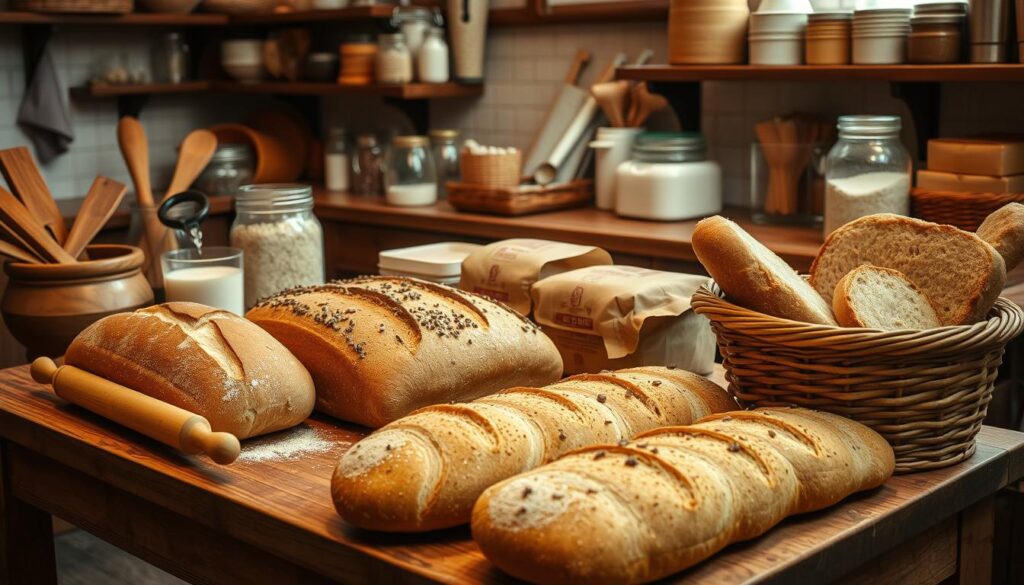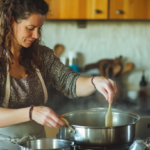Imagine freshly baked bread’s aroma filling your home with warmth. Baking bread is more than a project for many; it’s a passion. A stay-at-home mom turned this passion into a thriving business. She wanted to earn extra money while doing what she loved. Her journey into selling homemade bread showed her the demand for high-quality, artisanal products.
This small venture started by selling loaves to neighbors, friends, and at markets. Thanks to social media and word-of-mouth, her bread became popular. She avoided high rental costs of running a store by working from her home kitchen. She also understood cottage food laws and priced her bread for profit.
In this guide, we’ll show how you can start a rewarding journey of selling bread. You’ll learn beginner tips like understanding market needs, meeting legal requirements, and setting up an efficient kitchen. We’ll also cover marketing strategies for reaching local customers. Whether you’re baking part-time, retired, or turning a hobby into a career, these tips will help make your bread a success.
Key Takeaways
- Understand the economic benefits of operating a home-based bakery.
- Comply with local cottage food laws to ensure your business is legally sound.
- Focus on high-demand bread varieties to capture a wide customer base.
- Efficiently set up your kitchen to maximize productivity and meet customer demands.
- Leverage social media and local markets for effective, low-cost marketing.
- Price your bread wisely to ensure profitability, considering costs and margins.
- Aim for consistent quality to build a loyal customer base.
Research and Planning for a Homemade Bread Business
Starting a bread business needs careful research and planning. It’s the key to success and overcoming challenges. This strong foundation is critical for your bakery at home.
Market Research
Knowing the market is essential for selling bread. Homemade bread market research helps identify competitors and what customers like. The home baking market hit $3 billion in 2023. It’s growing because people prefer homemade things over store-bought ones, which rose by 25% from 2020 to 2023. This data helps you find a special spot for your bread.
Surveys show 60% of home bakers begin to earn extra money, and 40% do it as their main job. Understanding customer needs, like the desire for organic and local ingredients, helps you stand out. Tools like a Home Bakery Business Planning workbook are very helpful. Research shows that bread priced between $5-$10 sells best, capturing 45% of sales.
Business Plan
A thorough business plan is vital for a bakery business. It should cover goals, budget, pricing, and how to enter the market. This comes from your market research. Home bakers can make $20 to $40 an hour, depending on several factors. Starting costs are usually between $500 to $5,000, mainly for kitchen gear and good ingredients.
Success doesn’t happen overnight. It takes time to grow a baking business. The writer took 10 years to expand from baking a few cupcakes to 180 items each weekend. Planning carefully can lead to a full-time home bakery in a year or more. Focus on improving skills and making quality goods. Soon, 70% of home bakeries change to LLCs for financial safety and growth.
Doing your homework and planning carefully are crucial. They help you avoid mistakes and ensure your bread business lasts a long time. Start with solid, helpful advice for your homemade bread business to build a successful company.
Legal Considerations for Selling Bread from Home
Starting a home bakery is more than just loving to bake; you also need to know the legal stuff. It’s important to follow your area’s laws to keep your business safe and make your customers trust you.
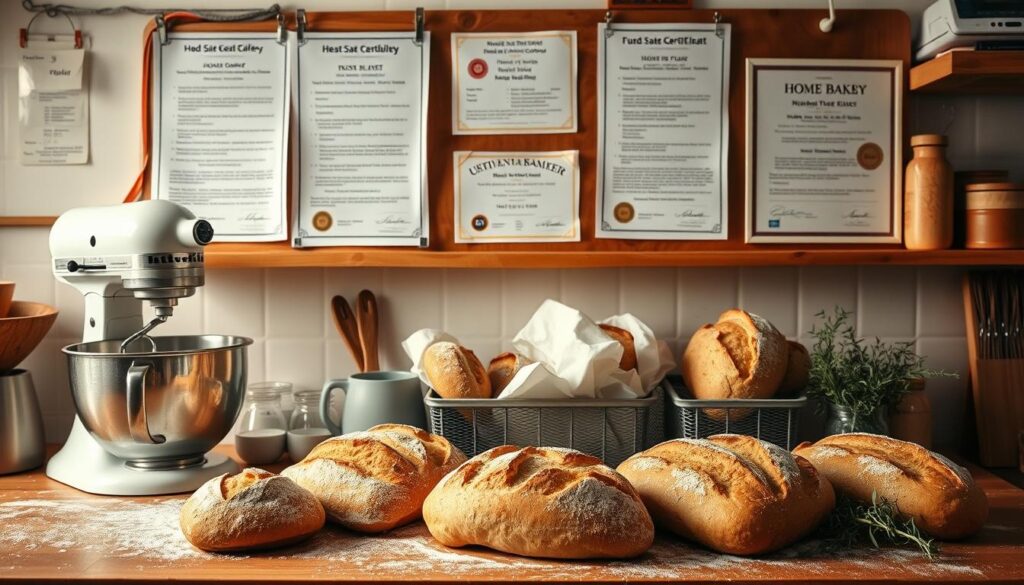
Cottage Food Laws
Cottage food laws are rules about selling homemade foods, and they’re different in each state. They usually cover what food you can sell, how much you can sell, and how you should run your bakery. For example, in Alabama, there’s no limit on how much you can sell, but in Alaska, you can’t make more than $25,000 a year from your home bakery.
Most people who start selling bread at home don’t hit these sales limits right away. So, the rules might not seem strict at first. But, you usually can’t sell stuff that needs to stay cold, like dairy or canned fruits.
Licensing and Permits
To sell bread from your house, you’ll need the right permits. What you need, like a business or food license, depends on where you live. Some places also make you take a course on food safety.
Home kitchens don’t get checked as much as restaurant kitchens, but they still have to meet health codes. Inspectors look for things like how clean your kitchen is and if you’re storing ingredients right.
Setting Up a Business Entity
Creating a business, like an LLC, helps protect your money and makes your bakery look professional. It’s important if you’re serious about selling bread. It also makes sure you’re following the food rules and helps customers see you as trustworthy.
It’s also key to label your products well, especially with allergen info. Good labels help customers know what they’re buying, building trust and happiness.
In the end, knowing about the legal side of running a home bakery is key. Following cottage food laws, getting the right licenses, and setting up a business are all steps to a successful bakery.
Setting Up Your Home Bakery
Starting a home bakery takes careful planning and organization. The home food market is expected to reach $20 billion by 2025. Now is a great time to start. We will look at important baking tools and how organizing your kitchen can make baking easier.
Essential Equipment for Bread Making
Choosing the right tools is very important for your home bakery setup. Setting up a bakery at home could cost about $1,000. This depends on the equipment and ingredients you choose. Below is a list of essential items:
- Baking Pans: Various sizes for different bread types.
- Measuring Tools: Precise cups, spoons, and a digital scale.
- Mixing Bowls: Multiple sizes, preferably stainless steel or glass.
- Stand Mixer: A sturdy model to handle large batches of dough.
- Thermometers: Both oven and dough thermometers for accuracy.
- Cooling Racks: Essential for even cooling to prevent soggy bottoms.
- Storage Containers: Airtight containers to keep ingredients fresh.
Having the right baking tools is the first step to prepare for various recipes. It helps you keep a professional quality in your baking.
Kitchen Organization Tips
Good kitchen organization is important for smooth workflow and productivity. Over half of the states have Cottage Food Laws. Knowing how to organize your kitchen space is crucial. Here are some helpful tips:
- Designate Baking Zones: Set up specific areas for preparation, baking, and cooling. This makes your baking process more efficient and organized.
- Storage Solutions: Use shelves and racks to save space. Clear containers with labels help you find things quickly and keep your kitchen tidy.
- Workspace Optimization: Keep counters clear for dough work and other tasks. A rolling cart is useful for holding and moving tools.
- Cleaning Routine: Keeping your kitchen clean is very important. Set times for cleaning before and after you bake. This keeps your space ready and safe for baking.
Smart kitchen organization for baking can save time and lessen stress. This helps your home bakery thrive.
Creating a Profitable Bakery Menu
Making a bakery menu that’s both irresistible and profitable is key for your home-based bakery. Picking the right breads can really make your menu stand out, satisfying customers and boosting profits. We’ll show you how to pick profitable breads and give you ideas for homemade bakery menu planning.
Choosing the Right Bread Varieties
To pick the right breads, you need to know your customers and what they like. Adding breads like sourdough, whole wheat, and specialty items can appeal to many tastes. This ensures you make a good profit.
- Sourdough – It has a distinct taste and lasts long, making it a favorite. Its long shelf life means less waste.
- Whole Wheat – This bread attracts those looking to eat healthily. It’s a must-have for any bakery making good profits.
- Specialty Breads – Breads with unique things like olives or sun-dried tomatoes can be sold for more money.
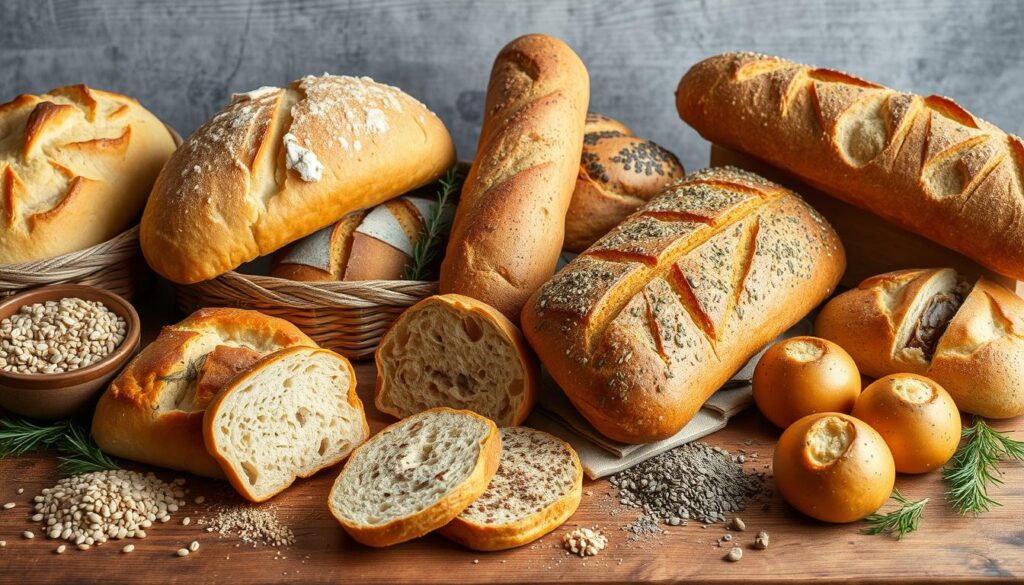
Sample Menu Ideas
A good menu balances variety and what you can actually make. Here are some ideas to get you started:
- Classic White Bread – Cheap to make and loved by many. It’s a basic item that appeals to most people.
- Multigrain Bread – Full of seeds and grains, it’s perfect for those who want to eat healthy.
- Focaccia – Great for sandwiches or by itself. You can add different flavors to it.
- Baguettes – Brings a French touch. Great for sandwiches or as a side for dinner.
By mixing these elements, you create a comprehensive bakery menu creation process. Having both daily items and unique offerings can draw in and keep a wide range of customers. This is how you make your home bakery successful.
Homemade Bread Recipes: Easy and Delicious Options
Making homemade bread is rewarding and saves money. By learning a few simple steps, you can bake wonderful bread quickly. We have several recipes, from basic sandwich bread to Amish white bread. All our recipes use active dry yeast, perfect for beginners.
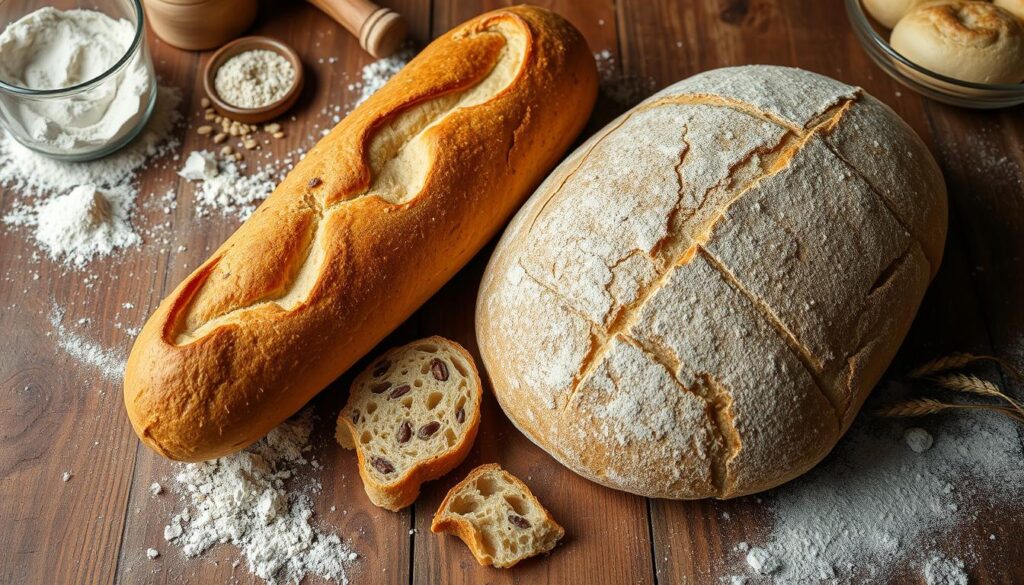
Homemade Sandwich Bread Recipes
Making your sandwich bread is fun and cost-effective. Making bread at home costs about $1 per loaf. This is cheaper than the $5 price tag for bread from stores, saving about $4. Active cooking time is only 15-20 minutes. Bake it at 375°F to get that golden crust.
Here’s what you will need:
- 3 to 3 ¼ cups flour
- 1 cup warm water (110-115°F)
- 2 ¼ teaspoons active dry yeast
- 2 tablespoons sugar (or use honey)
- 1 teaspoon salt
First, let the dough rise. It should double in size in 30 minutes to an hour. Then knead it for 5-10 minutes. Bake it for 23-27 minutes. You’ll get about 10 servings, with each having 312 calories.
Amish White Bread Recipe Homemade
The Amish white bread recipe is famous for its great taste and soft texture. Start by dissolving 2 ¼ teaspoons of active dry yeast in 1 cup of warm water. You should do this for about 5-10 minutes until it’s foamy. Then add the following:
- 3 to 3 ¼ cups flour
- 2 tablespoons sugar
- 1 teaspoon salt
This bread also follows the same steps of rising, kneading, and baking as the sandwich bread. The final product can stay fresh for days. It stays good at room temperature for up to 4 days. In the fridge, it lasts up to 9 days. Plus, you can freeze slices for 1-3 months without losing taste or texture.
Recipes Using Active Dry Yeast
Recipes with active dry yeast are great for those just starting to bake. It’s easy to use and reliable. To activate the yeast, mix it in warm water for 5-10 minutes until it foams. A common mix is 1 cup of warm water to 2 ¼ teaspoons of yeast. Here are some great recipes to try:
- Baguettes: Make crisp, airy baguettes with just a few ingredients.
- Rolls: Soft, buttery rolls are perfect for any meal and are always a hit.
- Pizza Dough: Create versatile pizza dough for various toppings. It bakes in just 10-12 minutes at 475°F.
In summary, using active dry yeast in your bread recipes makes baking easy and fun. You’ll get consistent, delicious results every time.
Pricing Your Homemade Bread for Profitability
Setting the right price for homemade bread is key to a lasting business. We’ll look at how to price your bread for profit. We offer a guide to help you find the best price.
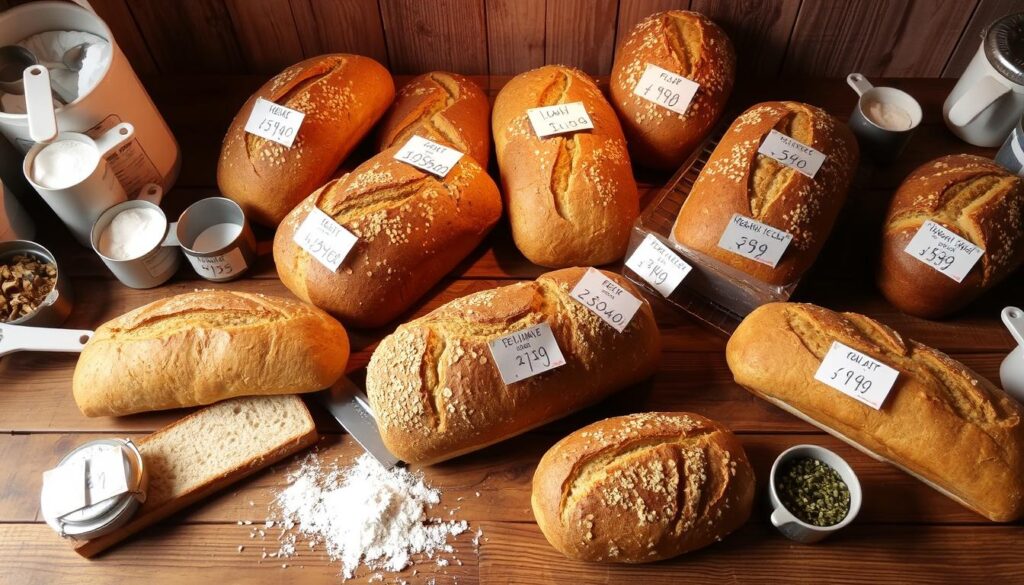
First, know your total cost to make bread. For example, using top organic ingredients, a loaf might cost $1.55 to make. This includes:
- Bread flour (600g): ~$1.20
- Salt (12g): ~$0.09
- Water: negligible cost
- Starter maintenance (weekly): ~$4.51
If you add special ingredients like vintage cheddar (150g), the cost goes up by about $2.00 a loaf.
Next, figure out the labor cost. Making 24 loaves at once, labor is about $0.25 for each loaf. But, if you make just 4 loaves, labor cost per loaf is $9.00. This assumes bakers are paid $18.00 an hour.
You should also think about utility costs, which include:
- Preheating (30 mins): $0.20 – $0.30
- Baking (45 mins): $0.34 – $0.45
- Cooling Period: $0.10 – $0.15
Utilities might cost about $45 a month, or $0.45 per loaf. Add $30 a month for equipment wear and $50 for packaging. These costs add about $1.25 to each loaf.
With all these costs in mind, the total overhead for each loaf is roughly $1.25.
Pricing your bread for profit is easier once you know your costs. A simple way is to multiply your total ingredient cost by 5. For example, if it costs $2.06 to make a loaf, then selling it at $3.50 using a Profit Index of 1.7 gives you a 70% profit.
Here’s how we worked it out:
- Ingredient cost per loaf: $1.55 (using the best organic ingredients) + $0.51 (including everything else) = $2.06
- Suggested selling price: $2.06 times 1.7 (Profit Index) = $3.50
Checking price differences in different places can help you find your spot in the market:
- Supermarket artisanal bread: $4.00 – $5.00
- Local bakeries: $4.20 – $8.00
- Premium artisanal markets: $6.00 – $12.00
With these pricing strategies, you can cover costs, stay competitive, and make your homemade bread business a success.
Marketing Strategies for Your Homemade Bread Business
Marketing well is key to making your homemade bread business thrive. The right moves not only draw in customers but keep them coming back. We’ll cover strategies like using social media, making a website, and getting involved in local markets.
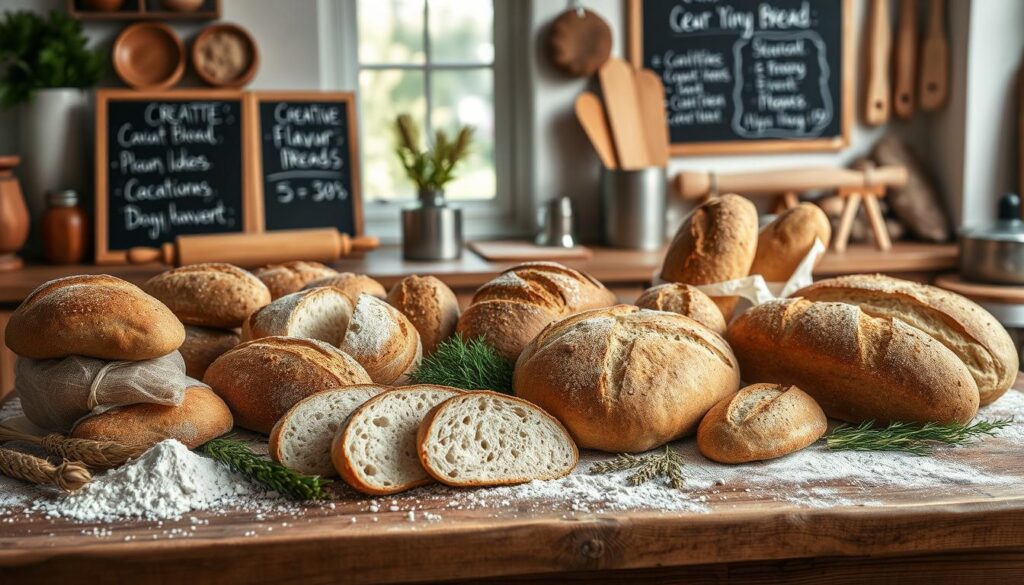
Utilizing Social Media
Talking to customers on social media is vital. It’s a top tool for 90% of businesses. Social media lets you meet lots of people and talk to them right away. Here’s what you can do:
- Post often with yummy bread photos. Use local hashtags to get 40% more eyes on your posts.
- Show what goes on behind the scenes. This helps followers feel a part of your baking world.
- Have special deals and use eye-catching signs to bring more people in. It works for 61% of small businesses.
Building a Website
Having a good website is crucial for selling your bread. It could bring in 30% of your sales through online orders. Make sure your website includes:
- A menu with great pictures of all your breads.
- Easy online ordering and payment to make things simple for buyers.
- A blog for sharing recipes, tips, and news. This draws more visitors and boosts your site’s importance.
Joining Local Markets
Local markets are great for getting seen and trying out new products. Being there can help 25% more new customers try your offerings. Here are some ideas:
- Give out free samples. They can increase sales by 30% to 50%. People who try tend to buy more.
- Have an attractive booth and use local ingredients. This matters to 63% of shoppers.
- Talk to customers face to face. This lets you build connections and get feedback to make your bread even better.
By putting these marketing strategies into action, you’ll boost your efforts in selling your homemade bread. Getting active on social media, having a professional website, and showing off at local markets will set you on the path to success.
How to Make Money Selling Homemade Bread: Tips for Beginners
Starting to earn money with homemade bread might seem tough. But, if you plan well, it becomes easier and rewarding. Start by following this homemade bread sales guide.
Start with good planning and knowing your market well. Figure out what people want, who will buy, and make a solid business plan. It’s also key to follow local food laws and get any permits needed.
Having the right kitchen setup is very important. Get the best tools for bread making and arrange your kitchen to work smoothly. Offer different bread types to attract more people. Look at these costs:
- Total cost for a large wheat-based sourdough loaf: $1.87.
- Total cost for an organic wheat sourdough loaf: $2.70.
- Total cost for an olive and rosemary bread: $4.34.
Understanding your costs is crucial for setting the right prices. For example, a sourdough loaf sold for about $8.50 each in June 2022. This info helps you price for profit.
Marketing well is also essential. Use social media to find customers, create a great website, and join local markets for more visibility. Being seen online boosts your brand and brings in buyers.
Make sure your bread is always top quality. Keep your standards high for every batch. Listen to what buyers say and keep improving your bread.
Handle your money wisely. Keep business banking separate and know your taxes. This step is crucial for bread selling for beginners and avoids money troubles later.
By using these detailed tips, you can make your home bakery thrive. Stay focused, keep learning, and be flexible to become successful.
Building a Customer Base
Having a strong customer base is key for a successful homemade bread business. Use word of mouth and bakery loyalty programs to get repeat business and keep customers happy.

Leveraging Word of Mouth
Word of mouth is very effective for small businesses, like home bakeries. Since 2005, many bakers turned their hobby into a booming business. Happy customers telling others about your bread can grow your base without big ad costs. Get your current customers to talk about your tasty homemade bread by:
- Offering incentives such as discounts for referrals
- Providing excellent customer service to ensure a positive experience
- Engaging with your community through local events and social media platforms
“Word of mouth marketing is essential for small businesses to grow without a large advertising budget. Happy customers are your best advocates.”
– Bakery Business Insight
Customer Loyalty Programs
Loyalty programs can help make a loyal customer base. Businesses with loyalty programs often see more sales and customers coming back. Here are ideas to create good loyalty programs for your bread business:
- Offer a ‘*buy five loaves, get one free*’ deal to encourage repeat purchases
- Use a points system where customers earn points for every purchase that can be redeemed for discounts or free products
- Provide exclusive access to new products or special offers for loyalty program members
By focusing on building a customer base with word of mouth and loyalty programs, you’ll grow a community of loyal customers. This will help your home-based bakery business flourish.
Managing Finances and Taxes for Your Home Bakery
Running a home bakery requires good financial management. Let’s explore how to handle your money well and learn about taxes needed for a bakery at home.

Separate Business Banking
It’s crucial to separate personal and bakery funds. Opening a business bank account helps track your bakery’s money flow better. This not only aids in bakery financial management but also makes bookkeeping and tax reporting easier.
- A separate business bank account helps in monitoring cash flow effectively
- It simplifies the process of filing for business deductions during tax season
- Assists in building a professional financial identity
Small business accounts are often offered by banks with low requirements. Keeping accurate records helps when applying for loans or investor funds.
Tax Considerations
Knowing about taxes for your home bakery is key. You could get tax breaks for things like ingredients, packaging, and part of your home expenses. This is if you have a specific area for baking.
“Home bakers should aim for a profit margin of at least 20%, often falling within the 20-50% range, depending on market demand.”
Talking to a tax expert is wise to avoid problems. They can explain which expenses to track and how to claim deductions.
- Keep detailed records of all business expenses and income.
- Consider using accounting software to streamline bakery financial management.
- Understand your state and local tax obligations, as they may vary significantly.
Good financial habits are key to avoiding tax season surprises. With careful planning, your home bakery can grow successfully.
Understanding Your Competition
In the bakery market competition, learning about your rivals is key. By analyzing baking competitors, you can create good plans for your homemade bread business.
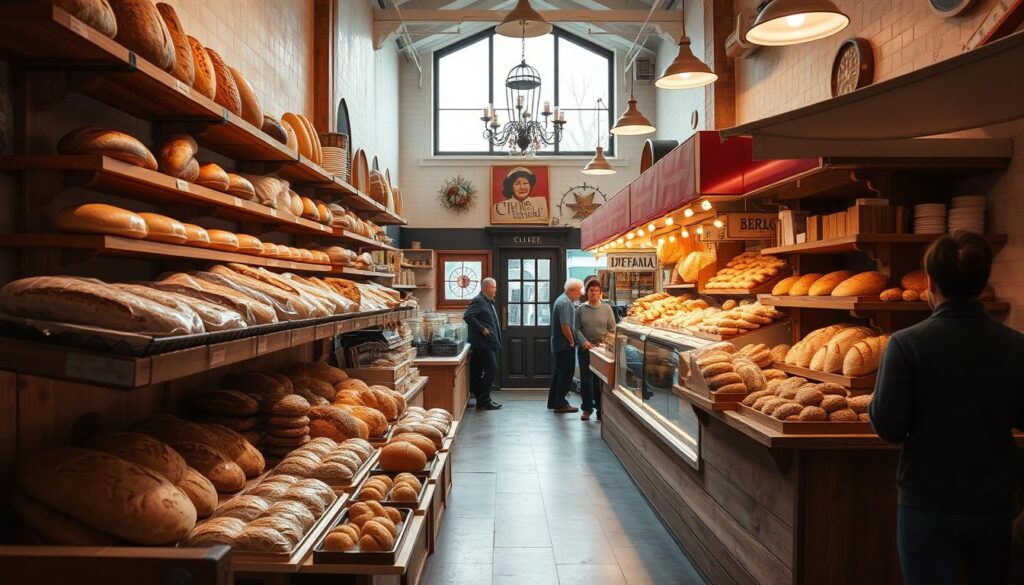
First, take a close look at the local bakery scene. Find out who your rivals are and what sets their products apart. Do they have gluten-free goods or use organic ingredients?
Research shows people are okay with paying more for items that are organic or local. This insight can guide you in deciding what to sell.
Competitive analysis in baking also means checking their pricing. Artisan breads, for example, are priced between $5 to $10 each. Make sure your prices are good but still let you make a profit. Successful bakeries often keep food costs below 35% for a healthy budget.
Then, look at how they market their products. About 70% of small food companies use social media to connect with customers. Watching how competitors market online can give you great ideas.
Finally, pay attention to what customers like and the feedback they give. Many customers, up to half, prefer trying new flavors over the usual kinds. Adding unique tastes can make your bakery stand out. Great packaging also matters to about 30% of buyers.
With thorough competitive analysis in baking, you’ll be ready to make your bakery special. It could be through unique products, smart pricing, or strong marketing. Knowing your competitors is crucial to do well in the baking world.
Expanding Beyond Bread: Diversifying Your Product Offerings
In the bakery world, diversifying bakery products is smart to grow income and attract more customers. If bakeries only sell bread, they might not make enough money. Including pastries and desserts helps keep earnings steady and pleases different preferences. With more people wanting healthy and special breads, there’s much room to grow your bakery’s offerings.
Adding Pastries and Desserts

Adding pastries and desserts opens doors to a bigger market. They’re loved by many and can really increase what you sell. Offering special items like gluten-free or vegan treats can reach even more customers. Some places saw customer interest jump by 35% with such options. Partnering with local cafes can make you more visible. Studies show this can boost joint marketing by 20-30%.
Seasonal and Special Occasion Items
Adding seasonal and special occasion items is another smart move. Holiday treats can draw in a lot of spending; holiday sales could top $900 billion in 2023. Gift baskets are also big, fetching $9.2 billion in sales in 2023.
Creating special desserts for events like weddings or birthdays makes you the place people think of for celebrations. This boosts sales now and builds customer loyalty for the future. Adding drinks can increase what each customer spends by about 30%, raising your profits.
Offering catering for events opens yet another revenue chance. Businesses can spend $200 to $400 on catering, showing a big opportunity for bakeries. By also selling pastries and desserts, you can offer a full menu, meeting more customer needs and capturing a larger share of the market.
Keeping Up with Trends in Homemade Baked Goods
Today’s baking world changes fast. For home bakers looking to do well, knowing the latest bakery trends is key. They mix old favorite recipes with new ingredients. 2021 was a year of comeback with treats like moon pies and toaster pastries getting popular again.
Sourdough bread has become a big deal because of its quality. Using this trend can boost your sales, particularly at local markets. Also, adding unique spices and making braided bread can bring a modern twist to classic bakes.
How a baked good looks is as important as how it tastes. Edible flowers and fancy patterns are part of the latest bakery trends. They not only look good but fit what customers now want in homemade treats. Favorites like apple pie and banana bread stay loved. But people also want new ingredients like cassava and almond flour.
The growth of trends in homemade baking includes the small, home-based businesses. Micro bakeries, often started by moms or young people, focus on niche products. For example, cinnamon rolls or cookie sandwiches can make these small bakeries successful.
Platforms like Castiron help bakers track their stock, handle online payments, and follow labeling rules. This makes it easier for them to sell local, community-supported foods. With such tech, keeping up with bakery trends and staying ahead is easier.
Following these baking trends keeps your products in line with what people want. This could be trying out new recipes, improving how your goods look, or using technology. Staying updated with the homemade baking scene is crucial for growing your baking business at home.
Tips for Beginners in Bread Baking
Becoming good at bread baking can be easier than you think. Just learn some basic bread making tips. Knowing the basics will greatly boost your baking game.
Basic Bread Making Techniques
Here are vital techniques for new bakers:
- Measuring Flour: Spoon flour into the measuring cup for a lighter loaf, instead of scooping it up.
- Temperature Control: The liquid for yeast must be just right. If it’s too cold, it won’t rise well. Too hot, and the yeast dies.
- Proper Kneading: Knead dough until smooth, which takes about 10 minutes. Mixing salt in later can shorten kneading time.
- Use of Steam: Steam in the oven makes your bread’s crust crusty and the inside soft.
- Ingredients at Room Temperature: For better mixing and fermentation, ingredients should be at room temperature.
Common Mistakes to Avoid
- Skipping the Cooling Period: Wait at least 15 minutes before cutting your bread. Cutting too soon can ruin it.
- Incorrect Flour Storage: Keep whole grain flours in the fridge or freezer. This keeps them fresh and tasty.
- Inconsistent Measurements: It’s vital to measure ingredients right. Use a scale or spoon flour into your cup.
- Neglecting Environmental Factors: Your bread can be affected by humidity and temperature. Remember to consider these factors.
- Overcrowding the Oven: Don’t put loaf pans too close. Space them out for even baking.
Know these basic tips and what mistakes to avoid. This will boost your bread baking. Remember, practice helps you get better. Each baking session is a chance to learn.
Case Studies: Successful Home Bakeries
Learning from those who’ve succeeded in the home bread business is very enlightening. We dive deep into case studies here. They highlight the strategies used and the hurdles faced by successful home bakeries.
Small-Scale Success Stories
Many start their journey to bakery success on a small scale. Consider Anna’s story, who began baking in her kitchen during the COVID-19 pandemic. She started just to keep busy, but positive feedback led her to take it further. The U.S. cottage food market has grown 300% between 2008 and 2019, putting Anna’s efforts into a broader perspective.
“I began with just two bread types and sold out within hours. The demand encouraged me to expand my offerings, and now I service clients throughout my town.” – Anna, Home Baker
Ben’s story is another example of making the most of limited space. He worked out of a tiny kitchen yet baked 1000 treats for a big event in days. His success came from careful planning and focusing on quality.
Lessons Learned from Experienced Bakers
There’s much to learn from bakery success stories for new entrepreneurs. Experienced bakers share essential advice:
- Start Small and Scale Gradually: Begin with a few products before expanding. These initial offerings need not be unique recipes but can be popular ones found online.
- Leverage Social Media: An effective online presence can boost sales. Like Emma, many bakers find that social media helps to build a strong customer base.
- Adapt to Regulations: Knowing state-specific laws, like Florida’s $250,000 sales cap, is important. This knowledge is key for those looking to grow and move to commercial kitchens.
- Focus on Quality: Quality is crucial, even in small setups. Happy customers come back, as they value the taste and quality over the baker’s qualifications.
These stories and tips from home bakeries show that with hard work, good planning, and a commitment to quality, starting a successful home bread business is possible for anyone ready to take the journey.
Promotional Ideas for Increasing Bread Sales
To boost your bakery, you’ll need bread sales promotion ideas that grab attention. The bread market in the U.S. is huge, with $30 billion in annual revenue. With creative promos, your bakery could reach more people and make more money.
Try engaging customers with social media contests. These can make more people notice and connect with your bakery. A good contest not only spreads the word but also increases your followers and interactions online.
“Buy one, get one free” deals are great for attracting new customers. They encourage people to try your bread. This approach boosts sales and helps reduce waste from unsold products.
Free delivery can make customers happier and encourage them to order more. When delivery fees are gone, people often buy more. Also, an online ordering system can bring in more customers without costing a lot upfront.
Videos are key in today’s marketing world. About 54% of consumers want videos from their favorite brands. Using YouTube and TikTok can increase visibility and even bring in extra money.
Don’t forget traditional media like newspapers and magazines. They’re still powerful for reaching the community. They’re great for advertising special items or diets, like gluten-free or vegan options.
Loyalty programs also keep customers coming back. For example, a free bun with a five-bun purchase can build loyalty.
Using these bread sales promotion ideas will improve your sales and customer interest. Your bakery can grow and succeed over time.
Quality Control: Ensuring Consistency and Freshness
For a home bakery to stand out, keeping quality high is key. Quality control in a bakery means checking that every loaf is as good as the next. This includes choosing the right ingredients, like special bread flour, and controlling the water amount for different breads. Keeping an eye on how bread rises and proofs is also crucial for the best taste and feel.
Maintaining High Standards
Keeping bread fresh matters a lot in quality control. This means getting the water in the dough just right. The amount of water affects how soft or dense the bread is. The browning and taste of the crust are improved through a process that happens when baking.
It’s important to watch how the bread rises and proofs. Doing it right avoids bread that’s too dense or falls flat. Bakers also need to make sure they use the best ingredients. The protein in bread flour helps the bread stay structured. Using yeast the right way also plays a big part in how light or heavy the bread feels.
Customer Feedback and Adjustments
Listening to what customers say is key for improving baked goods. By taking their suggestions, bakers can make their recipes better. For example, if bread is too dry or bland, changing the water amount or recipe can fix it. Acting on customer feedback shows commitment to quality and keeps them coming back.
In the end, keeping quality high and valuing customer opinions are vital in bakery quality control. These steps keep the bread fresh and tasty. They make sure customers get what they like, which helps build a strong and loyal following.
Sustainability Practices in Home Baking
Using sustainable baking practices can make your baking more efficient. It also attracts customers who care about the environment. An easy way to be more eco-friendly is by choosing local, organic ingredients. Using special flours like Climate Blend and Golden Whole Wheat Flour helps the earth. These flours support farming methods that use less chemicals.
Reducing waste is very important for a home bakery that wants to be sustainable. You can use parchment paper many times, which cuts down on waste. Choosing oat or soy milk instead of cow’s milk also helps the planet. It leads to fewer greenhouse gases and requires less water.
Eco-friendly packaging is another way to bake sustainably. Instead of using plastic wrap once, opt for something you can use again and again. You can also use leftover bread in creative ways. This helps deal with the big problem of food waste in homes.
Adopting these practices not only helps the earth but also makes your bakery more appealing. There’s a growing number of consumers who prefer products that are kind to the environment.

